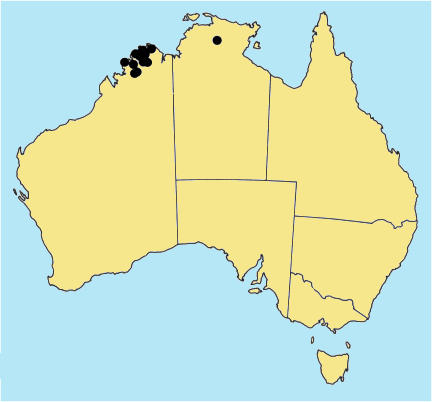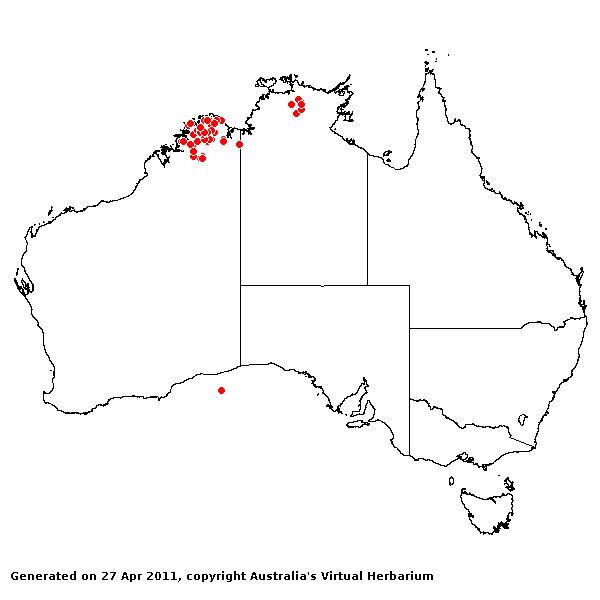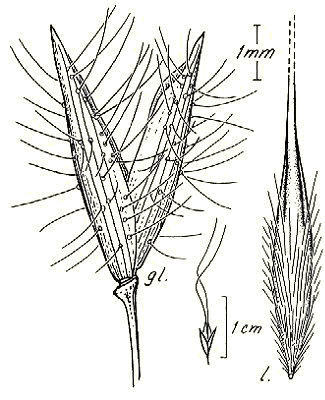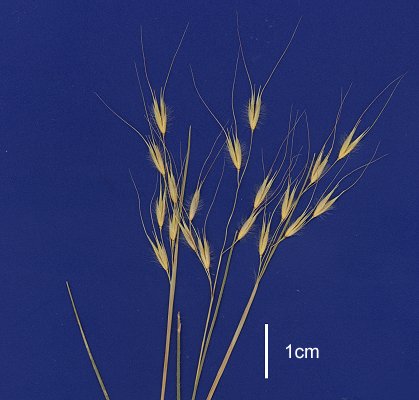Eriachne pauciflora W. V. Fitzg. J. & Proc. Roy. Soc. W.A. 3: 115 (1918).
Classification. (GPWG 2001) : Subfamily Micrairoideae. Eriachneae.
Type of Basionym or
Protologue Information: Australia, Edkins Range: Fitzgerald 1461
(PERTH holo, US).
Key references
(books and floras): [1952] C.A.Gardner, Flora of Western Australia 1
Gramineae (48), [2002] D.Sharp & B.K.Simon, AusGrass, Grasses of
Australia.
Illustrations:
[2005] K.Mallet (ed.), Flora of Australia 44B: Poaceae 3 (Fig.
24I-J).
Habit. Annual
or perennial. Rhizomes present, elongated. Culms erect, 14–85 cm tall. Mid-culm
nodes glabrous or pubescent or bearded. Lateral branches simple or branched.
Leaves mostly basal. Ligule a fringe of hairs. Leaf-blades filiform, 1.9 cm
long, 1–4 mm wide. Leaf-blade surface scaberulous or scabrous, glabrous or
indumented.
Inflorescence.
Inflorescence compound, a panicle or a panicle. Panicle 3–6(–10) cm long,
(0.8–)1.5–2(–3) cm wide.
Spikelets.
Spikelets pedicelled. Fertile spikelets 2-flowered, both fertile, comprising 2
fertile floret(s), without rachilla extension, ovate, laterally compressed, 5
mm long.
Glumes.
Glumes similar, thinner than fertile lemma. Lower glume lanceolate or ovate,
membranous, without keels, 7–13 -nerved. Lower glume surface glabrous or
indumented. Lower glume apex muticous or mucronate. Upper glume lanceolate or
ovate, 3.3–10 mm long, membranous, without keels, 7–13 -nerved. Upper glume
surface smooth or scabrous, glabrous or indumented. Upper glume apex muticous
or mucronate.
Florets.
Fertile lemma 3.5–8 mm long, without keel, 5–7 -nerved. Lemma surface
indumented. Lemma apex awned, 1 -awned. Median (principal) awn 7–27(–43) mm
long overall. Palea apex entire or dentate, muticous. Grain 2–3 mm long.
Continental
Distribution: Australasia.
Australian
Distribution: Western Australia, Northern Territory.
Western Australia:
Gardner. Northern Territory: Darwin & Gulf.
Notes.
Noteworthy characters include florets slightly longer than glumes, a bisulcate
awned partly hirsute lemma, a beaked palea longer than body of its lemma, and
glumes with a deep constriction at their base. Eriachne pauciflora has
similarities with E. sulcata and E. rara, but differs from the
former species by its looser panicles, smaller spikelets, florets longer than
glumes, shortly acute or obtuse glumes with a usually sparser indumentum, and
by a longer lemma awn. Eriachne rara is readily distinguished by the
absence of grooves on its lemma.
Endemic.
Kimberley region of W.A. and Kakadu Natl Park, N.T. Seasonally wet and damp
sites such as the levees and banks of creeks, swamps, seepage and drainage
lines, usually in alluvial, or shallow sandy or gravelly soils, in association
with sandstone, basalt and laterite. Flowers and fruits Jan.-Sept. (mid-summer
to early-spring).





